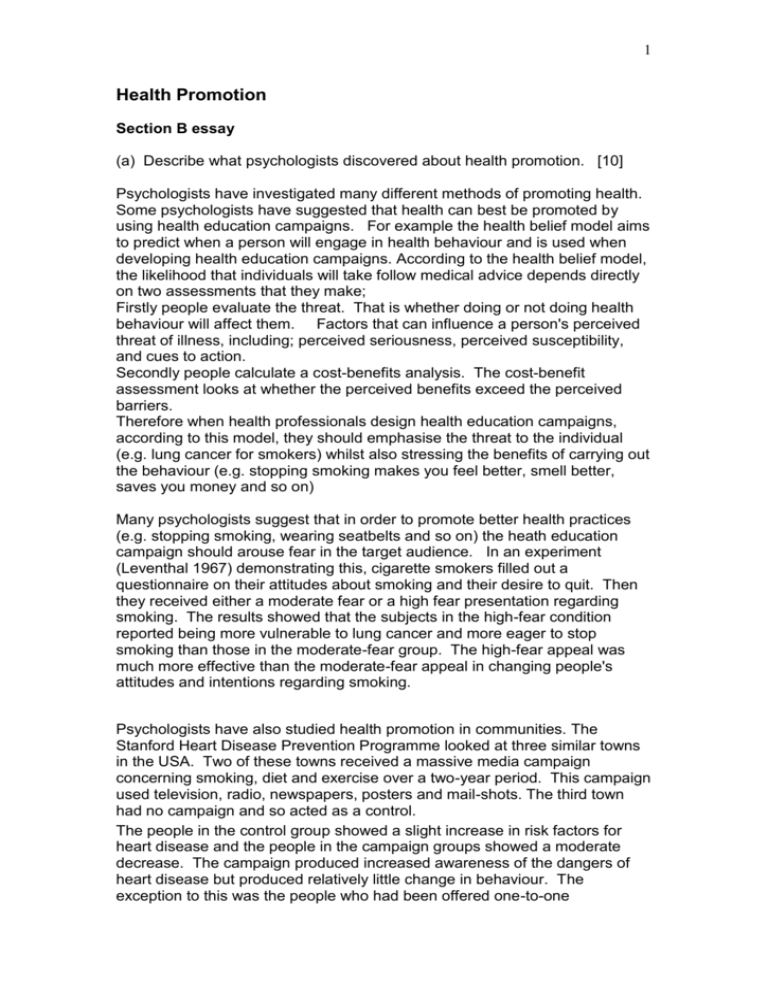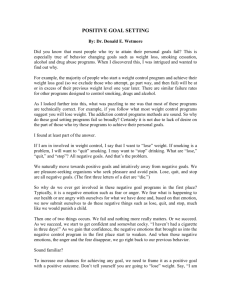Health Promotion - Holah Psychology
advertisement

1 Health Promotion Section B essay (a) Describe what psychologists discovered about health promotion. [10] Psychologists have investigated many different methods of promoting health. Some psychologists have suggested that health can best be promoted by using health education campaigns. For example the health belief model aims to predict when a person will engage in health behaviour and is used when developing health education campaigns. According to the health belief model, the likelihood that individuals will take follow medical advice depends directly on two assessments that they make; Firstly people evaluate the threat. That is whether doing or not doing health behaviour will affect them. Factors that can influence a person's perceived threat of illness, including; perceived seriousness, perceived susceptibility, and cues to action. Secondly people calculate a cost-benefits analysis. The cost-benefit assessment looks at whether the perceived benefits exceed the perceived barriers. Therefore when health professionals design health education campaigns, according to this model, they should emphasise the threat to the individual (e.g. lung cancer for smokers) whilst also stressing the benefits of carrying out the behaviour (e.g. stopping smoking makes you feel better, smell better, saves you money and so on) Many psychologists suggest that in order to promote better health practices (e.g. stopping smoking, wearing seatbelts and so on) the heath education campaign should arouse fear in the target audience. In an experiment (Leventhal 1967) demonstrating this, cigarette smokers filled out a questionnaire on their attitudes about smoking and their desire to quit. Then they received either a moderate fear or a high fear presentation regarding smoking. The results showed that the subjects in the high-fear condition reported being more vulnerable to lung cancer and more eager to stop smoking than those in the moderate-fear group. The high-fear appeal was much more effective than the moderate-fear appeal in changing people's attitudes and intentions regarding smoking. Psychologists have also studied health promotion in communities. The Stanford Heart Disease Prevention Programme looked at three similar towns in the USA. Two of these towns received a massive media campaign concerning smoking, diet and exercise over a two-year period. This campaign used television, radio, newspapers, posters and mail-shots. The third town had no campaign and so acted as a control. The people in the control group showed a slight increase in risk factors for heart disease and the people in the campaign groups showed a moderate decrease. The campaign produced increased awareness of the dangers of heart disease but produced relatively little change in behaviour. The exception to this was the people who had been offered one-to-one 2 counselling; these showed significant changes in behaviour. This study suggests that mass media campaigns by themselves produce only small changes in behaviour, but they can act as a cue to positive action if further encouragement is offered. Psychologists have also studied workplace wellness programmes. Workplace wellness programmes are run by companies, with the goal of attaining and maintaining employee health. These programmes seek to make the workplace healthier by making changes in the work environment and in employees' health behaviours. A smoking ban in Australian ambulance crews was monitored by self report measures, and also by physiological measures such as blood and exhaled carbon dioxide. The measures were taken just before the ban, just after it, and again six weeks later. The self report results showed that the ambulance crews reported less smoking both at the start of the ban and after six weeks. The physiological measures, however returned to the baseline measures after six weeks, suggesting that the smokers were finding other times to smoke, or were maybe finding secret places to smoke while at work. This suggests that worksite smoking bans might well be useful in changing behaviour at work, and also improving the quality of life for non-smokers, but their overall effectiveness in reducing smoking is far less clear. Evaluate what psychologists have discovered about health promotion [16] One issue that arises when psychologists study health promotion is ethics. Ethics are often a problem for psychologists because when we study people we should not harm them in any way. However in the Leventhal study on fear arousal the participants who were subjected to the high fear condition could have been upset by the video and in fact some of the participants were so distressed they had to leave the room. In comparison we can argue that studies such as the Stanford Heart Disease Prevention Programme are unethical because they use a control group who are deprived of the extra health promotion that the experimental groups receive. However at the same time we could argue that if the study had not been done the two experimental groups would not have received the health promotion anyway. Another issue which arises when we study health promotion is the sample. For psychologists to make generalisations they should have a representative sample. The Stanford Heart Disease Prevention Programme interviewed several hundred people in the three towns between the ages of 35 and 60. This seems to be a large enough sample to make generalisations although we should still be cautious generalising the findings to non US citizens. In contrast Gomel’s study of Ambulance drivers had a much narrower sample of participants who were all probably from similar backgrounds so we would have to be careful generalising the findings to other types of workers. 3 A further issue which arises when we study health promotion is demand characteristics. Participants may not tell the truth about their health behaviour and may give answers the researchers are expecting. For example, in Leventhal’s study participants in the high fear condition may say they are not going to smoke because that is what the researchers expect to hear. They may however simply carry on smoking. In comparison participants in the Gomel study also demonstrated demand characteristics as they said they had stopped smoking but physical evidence suggested that they were still smoking. Finally we can also evaluate psychological evidence into health promotion by looking at the issue of reductionism. There are many factors influencing whether people will follow health promotion and to only focus on one factor would be reductionist as it would be ignoring these many factors. The Health Belief Model is good in that it investigates many factors affecting whether people will follow health promotion. For example it takes into consideration the persons beliefs, their family and social background and also the cues to action. In contrast Leventhal’s fear arousal study could be seen to be reductionist as it only focuses on fear as a motivating factor and ignores other factors such as the social and financial background of people.




